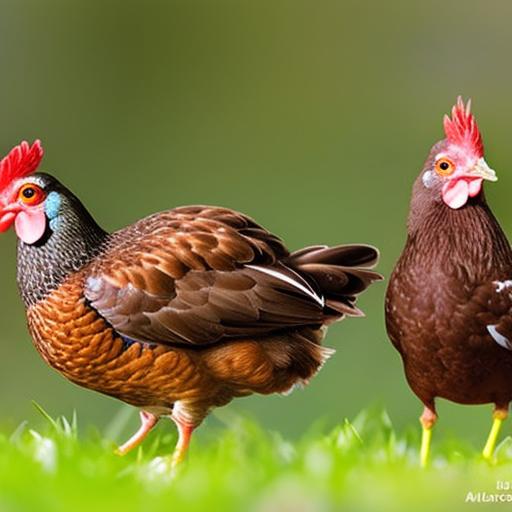Proper lighting is essential for chicken coops, especially when it comes to egg production. Chickens rely on light to regulate their reproductive system and stimulate egg production. In this article, we will explore the importance of lighting for egg production, factors to consider when choosing lighting for your chicken coop, the pros and cons of natural and artificial light, the ideal light schedule for laying hens, choosing the right bulbs, installing and maintaining lighting in your chicken coop, and the benefits of proper lighting for your chickens and your wallet.
Key Takeaways
- Lighting is crucial for egg production in chickens.
- Factors to consider when choosing lighting for your chicken coop include intensity, duration, and color temperature.
- Natural light is preferred, but artificial light can be used to supplement or replace it.
- The ideal light schedule for laying hens is 14-16 hours of light per day.
- LED bulbs are the best choice for chicken coops due to their energy efficiency and long lifespan.
Understanding the Importance of Lighting for Egg Production
Lighting plays a crucial role in egg production in chickens. The amount and quality of light that chickens are exposed to can directly impact their reproductive system. Chickens require a certain amount of light to stimulate their pituitary gland, which in turn triggers the release of hormones necessary for egg production. Without adequate lighting, hens may experience a decrease in egg production or even stop laying eggs altogether.
In addition to stimulating egg production, lighting also helps regulate the timing of egg laying. Chickens are naturally inclined to lay eggs during daylight hours. By providing consistent and appropriate lighting in the coop, you can help ensure that your hens lay their eggs at the desired time. This can be particularly useful if you want to collect eggs in the morning or if you are using artificial lighting to extend the day length during the winter months when natural daylight is limited.
Factors to Consider When Choosing Lighting for Your Chicken Coop
When choosing lighting for your chicken coop, there are several factors to consider. The size of your coop and the number of chickens you have will determine how many lights you need and how they should be positioned. It’s important to provide enough light so that all areas of the coop are well-lit, but not so much that it causes stress or discomfort for your chickens.
Another important factor to consider is the safety of the lighting for your chickens. Make sure to choose lighting that is specifically designed for use in agricultural settings and is safe for animals. Avoid using regular household bulbs or fixtures, as they may not be suitable for the unique needs of a chicken coop.
Natural Light vs Artificial Light: Which is Better for Your Chickens?
Both natural and artificial light have their advantages and disadvantages when it comes to chicken coops. Natural light is the most natural and cost-effective option, as it provides the full spectrum of light that chickens need. It also helps regulate their circadian rhythm, which can have a positive impact on their overall health and well-being. However, natural light is not always consistent, especially during the winter months when daylight hours are shorter.
Artificial light can be used to supplement natural light or provide consistent lighting throughout the year. It allows you to control the amount and duration of light your chickens are exposed to, which can be particularly useful for stimulating egg production or extending daylight hours during the winter. However, artificial light can be more expensive to install and maintain, and it may not provide the same benefits as natural light.
The Ideal Light Schedule for Laying Hens
The ideal light schedule for laying hens depends on several factors, including the breed of chickens, their age, and the desired egg production. In general, laying hens require 14-16 hours of light per day to stimulate egg production. This can be achieved by providing a combination of natural and artificial light.
If you are using artificial lighting, it’s important to gradually adjust the light schedule to avoid stressing out your chickens. Start by adding an extra hour of light in the morning or evening and gradually increase it over a period of several weeks until you reach the desired duration. Similarly, when reducing the amount of light during the winter months, do so gradually to avoid sudden changes that could disrupt egg production.
Choosing the Right Bulbs for Your Chicken Coop

When it comes to choosing bulbs for your chicken coop, there are several options to consider. LED bulbs are a popular choice due to their energy efficiency and long lifespan. They also produce less heat, which can be beneficial in a confined space like a chicken coop. Compact fluorescent bulbs are another option, although they may not last as long as LED bulbs.
It’s important to choose bulbs that provide the appropriate spectrum of light for chickens. Full-spectrum bulbs or those specifically designed for poultry are recommended, as they mimic natural sunlight and provide the necessary wavelengths for optimal egg production. Avoid using colored or dimmed bulbs, as they may not provide the same benefits.
Installing Lighting in Your Chicken Coop: Tips and Tricks
When installing lighting in your chicken coop, there are a few tips and tricks to keep in mind. Position the lights so that they evenly distribute light throughout the coop, ensuring that all areas are well-lit. Consider using multiple lights instead of relying on a single source to avoid shadows or dark spots.
It’s important to protect the wiring from your chickens, as they may peck at it or cause damage. Use wire covers or conduit to enclose the wiring and prevent access. Make sure all electrical connections are secure and properly insulated to avoid any potential hazards.
Maintaining Lighting in Your Chicken Coop: Common Problems and Solutions
Like any other electrical system, lighting in chicken coops can experience problems over time. Bulb burnout is a common issue that can be easily resolved by replacing the bulb with a new one. Make sure to keep spare bulbs on hand so that you can quickly replace any burnt-out bulbs.
Wiring issues can also occur, especially if your chickens peck at the wiring or if it becomes damaged over time. Regularly inspect the wiring for any signs of wear or damage and repair or replace it as needed. It’s also a good idea to periodically check the connections and ensure they are secure.
The Benefits of Proper Lighting for Your Chickens and Your Wallet
Proper lighting in your chicken coop can have several benefits for both your chickens and your wallet. Adequate lighting stimulates egg production, resulting in a higher yield of eggs. It also helps regulate the timing of egg laying, making it easier for you to collect eggs at the desired time.
In addition to increased egg production, proper lighting can also improve the overall health and well-being of your chickens. Exposure to the right amount and quality of light helps regulate their circadian rhythm, which can have a positive impact on their sleep patterns, behavior, and overall health.
From a financial perspective, proper lighting can save you money in the long run. Energy-efficient bulbs, such as LED bulbs, consume less electricity and have a longer lifespan compared to traditional incandescent bulbs. This can result in lower energy bills and reduced maintenance costs.
The Best Light for Your Chickens Laying in Your Coop
In conclusion, proper lighting is crucial for chicken coops, especially when it comes to egg production. Understanding the importance of lighting and its impact on the reproductive system of chickens is essential for maximizing egg production.
When choosing lighting for your chicken coop, consider factors such as the size of the coop, the number of chickens, and the safety of the lighting. Natural light is the most natural and cost-effective option, but artificial light can be used to supplement or provide consistent lighting throughout the year.
The ideal light schedule for laying hens depends on various factors and can be achieved by gradually adjusting the light schedule. Choose bulbs that provide the appropriate spectrum of light for chickens, such as LED or full-spectrum bulbs.
When installing lighting in your chicken coop, position the lights to evenly distribute light and protect the wiring from your chickens. Regularly maintain the lighting system by replacing burnt-out bulbs and inspecting the wiring for any issues.
Proper lighting has numerous benefits for your chickens, including increased egg production and better overall health. It can also save you money in the long run by reducing energy consumption and maintenance costs.
In conclusion, the best light for your chickens laying in your coop is a combination of natural and artificial light that provides the appropriate spectrum and duration. Share your own experiences with lighting in your chicken coop and continue to explore ways to optimize egg production and the well-being of your chickens.
If you’re looking for the best way to keep your chickens laying consistently, you’ll want to check out this informative article on Poultry Wizard. They discuss the benefits of using the Producers Pride Sentinel Chicken Coop, which is designed to provide optimal lighting conditions for your hens. With its innovative features and durable construction, this coop ensures that your chickens receive the right amount of light to stimulate egg production. To learn more about this fantastic coop and how it can benefit your flock, click here: Producers Pride Sentinel Chicken Coop.
FAQs
What is the best light to keep chickens laying?
The best light to keep chickens laying is a 40-watt bulb that emits a warm, yellow light.
How many hours of light do chickens need to lay eggs?
Chickens need 14-16 hours of light per day to lay eggs consistently.
What type of light bulb should I use for my chickens?
You should use a 40-watt incandescent bulb or a red heat lamp bulb for your chickens.
When should I turn on the light for my chickens?
You should turn on the light for your chickens early in the morning, before sunrise, and turn it off in the evening, after sunset.
Can I use natural light instead of artificial light for my chickens?
Yes, you can use natural light instead of artificial light for your chickens, but you may need to supplement with artificial light during the winter months when daylight hours are shorter.
What are the benefits of using a light for my chickens?
Using a light for your chickens can help them lay eggs consistently, even during the winter months when daylight hours are shorter. It can also help regulate their circadian rhythms and improve their overall health and well-being.
Meet Walter, the feathered-friend fanatic of Florida! Nestled in the sunshine state, Walter struts through life with his feathered companions, clucking his way to happiness. With a coop that’s fancier than a five-star hotel, he’s the Don Juan of the chicken world. When he’s not teaching his hens to do the cha-cha, you’ll find him in a heated debate with his prized rooster, Sir Clucks-a-Lot. Walter’s poultry passion is no yolk; he’s the sunny-side-up guy you never knew you needed in your flock of friends!







